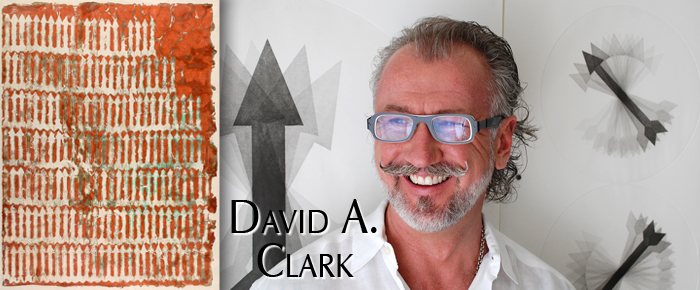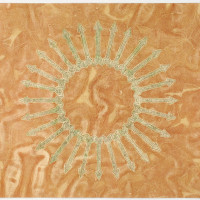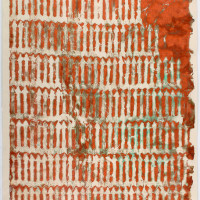
By Angela Valente Romeo
I remember an episode from the TV show Taxi; someone asks the collective drivers what they do for a living. Only one, Alex Rieger, answers truthfully, “Me? I am a taxi driver.” No qualifications just stating the fact. Ask David A. Clark what his response is and it is just as clear and true, “I am an artist.”
David A. Clark has been an artist his whole life. “I have always wanted to tell stories, that is what an artist does, tells a story. As a child I was an actor and over the years my creative medium changed but the objective to tell a story has never been lost. Being an artist is a great job. Every day one learns something – about oneself, about others, about the world. Everyday is a learning experience and a chance to evolve.”
“Recently, I spent 10 days teaching encaustic print workshops in Holland. I love teaching and I always learn something from my students. This international group of students approached the workshop much differently from the American students I have taught previously. They were more reserved, more frugal with the materials they used. American students tend to work larger. These students worked much smaller. Initially I thought these students were less free creatively but what I learned is that their approach to the material was unique from mine and my other students. Even though I have taught many workshops I still learn from watching my students. There is a comfort level in creating art and that differs greatly from person to person and culture to culture.”
“The level of comfort extends to those who view my work. I find people are not always comfortable discussing ‘art’ so they will ask the safe question: what is the process. Encaustic printing evolved from the ancient art of encaustic painting. I use wax and heat to transfer an image on to paper. It is a difficult process to describe but once we get past the process, I hope the viewer will begin to hear and see the stories of the work because telling stories is the reason I create work. It is all about communication.”
Much of David’s work concerns our history, “The human experience as trajectory. Our collective cultural history is an archive of memories passed down and interpreted by artists – orally or visually. That is our legacy as artists – to preserve the human experience.”
A reoccurring motif in David’s work is the arrow. “Arrows have been a fixture in my work since the beginning and arrows are a powerful symbol for me. The idea of human trajectory as embodied by an arrow inspires me. That idea of trajectory represents a place in my history as a creative person where anything is possible, where any idea can be realized in whatever form without judgment and without limits. The Arrow is the flow of humanity – the arc of the human experience – collective and the individual each being a larger part of our cultural humanity.”
“I am intrigued by the trace marks of mankind. Humans have always left markers, from cave drawings to trail markers to great works of art; we have always left traces of our paths. Though today, we seem to be a few steps removed from the person and the object. In contemporary society we are digitized, social media-tized and at times removed from the creator and the object. We have digitized the human experience.
“To me interesting work is an emotional and physical legacy. My new body of work is collage of single-family portraits in trajectory of arrows. These collected memories may not be mine but the collages are universal snapshots of experience; they are moments of accumulated human trajectory captured during their journey.”
David’s work Ancient Histories #151 is an encaustic monoprint on Kozo, a Japanese paper made from vegetable fibers. “Ancient Histories #151 is an exploration of the trace marks we leave behind. The arrows are the skeletal remains of our thought and deeds, symbolizing the remnants of our trajectory past.”
What does the future hodl for David A. Clark? “ I will continue to expore the human trajectory. The significant change is the expansion of the scale of my work. The increase in size presents some technical issues but the challenge more than justifies the journey.”
For more on David A. Clark visit www.davidaclark.com. For more information on the PS Art Museum ACE, visit www.psmuseum.org/palm-springs/exhibition/artists-council-exhibition-2015.
















































